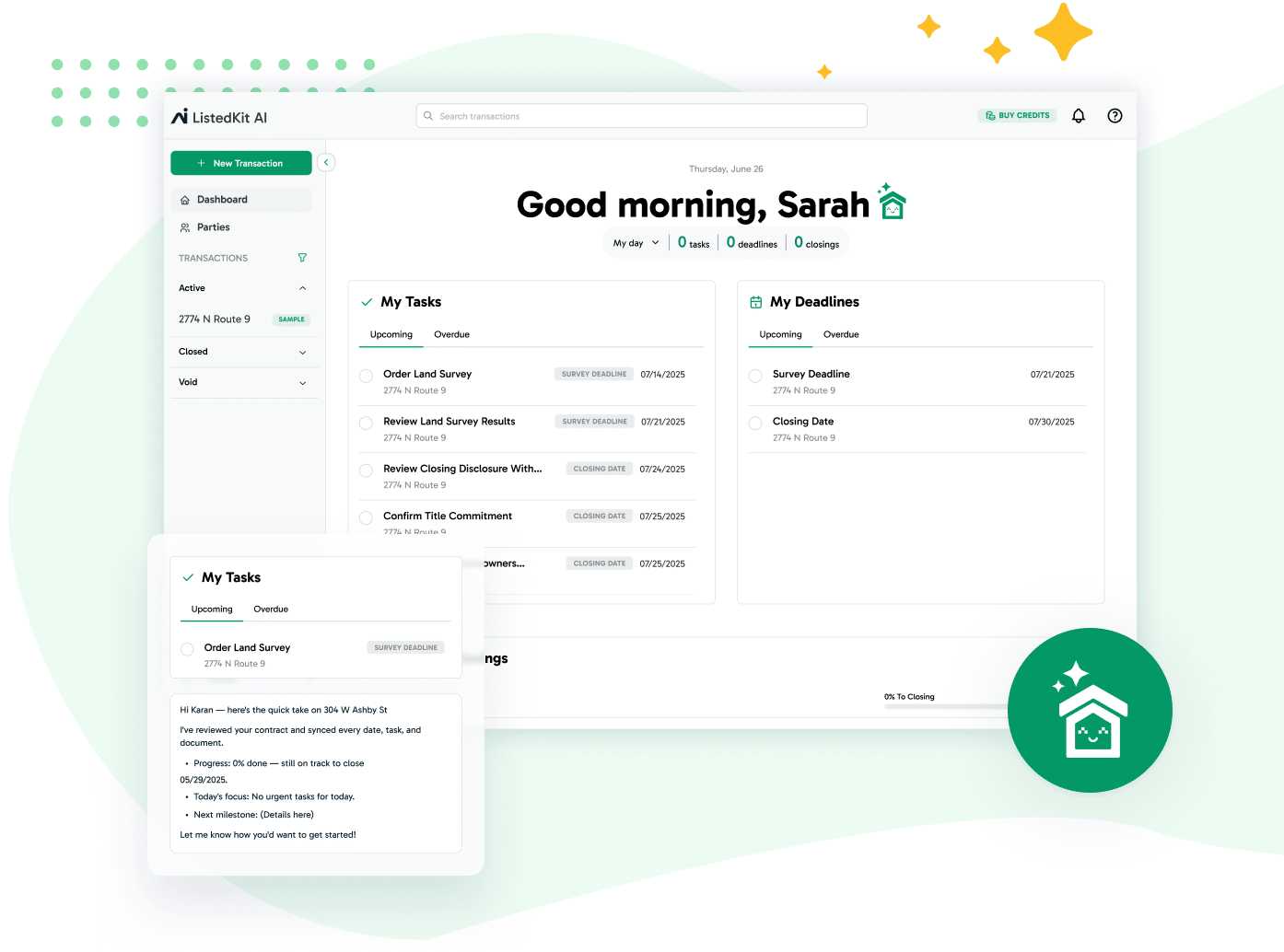If you’re a transaction coordinator, you already know that constant deadline questions are part of the job.
- “When’s the inspection?”
- “Did the appraisal go through?”
- “Are we still on track to close?”
These updates matter a lot. But doing them for different clients and multiple transactions daily can quietly drain your time and focus. Having a concrete real estate transaction tracker process can make a noticeable difference.
In this article, we’ll walk you through three tools real estate professionals commonly use to keep everyone on the same page. We’ll break down what each one does well, where it falls short, and how to choose a setup that works for how you run your transactions.
1. ListedKit: Transaction Management Software
ListedKit is built specifically for real estate professionals handling multiple transactions at once. It combines task tracking, deadline management, and communication into one tool. That way, you’re not flipping between Google Sheets, scattered emails, and last-minute text messages.

Here’s what else it offers:
- A centralized system for deadlines, signatures, inspections, and more
- Integration with client portals, so buyers and sellers can check the timeline without calling you
- Role-specific access for agents, lenders, and admin staff
- Notifications that go out before a deadline is missed—not after
This level of visibility can support stronger customer relationship management, especially when multiple parties are involved. When people don’t need to ask you for updates, they trust the system more—and you can focus on moving the deal forward.
Real-World Use
A real estate team using ListedKit during high season reported fewer delays and fewer missed emails from agents. By reducing status check-ins, they could close more transactions and simplify compliance.
In terms of business impact, it also supports your financial performance. If you’re working solo or running a TC agency, fewer hours spent sending updates can help you take on more transactions or improve response time for your best clients. That’s time back in your day and stronger results for your business goals.
Additional Features That Matter
Beyond the basics, ListedKit includes helpful tools that make it easier to track real estate transactions from offer to close—without introducing clutter or complexity. These features are designed to keep your workflow organized, scalable, and easily monitored throughout your checklist.
Compliance Review That Keeps You on Track
When working across multiple contracts and deadlines, staying on top of compliance can easily fall to the bottom of the list—until it becomes a problem. ListedKit includes a built-in compliance review that supports your transaction oversight from beginning to end.
- Set automated reminders for internal reviews
- Track which documents and tasks have been reviewed
- Monitor audit-related steps without extra spreadsheets
It’s a simple way to protect your process while ensuring your files are in shape for closing or broker audits.
Task Templates for Repeatable Workflow
If you manage dozens of real estate transactions at different stages, having a consistent workflow makes a huge difference. ListedKit allows you to build reusable task templates—customized by region, property type, or team structure—so every transaction follows a clear process.
- Set up task kits for different transaction types
- Standardize your process without recreating steps each time
- Speed up onboarding for new team members or assistants
This feature can be especially useful for teams tracking progress across multiple users or TCs handling a high volume of similar files.
Custom Email Templates Linked to Task Progress
Keeping agents and clients updated doesn’t have to mean writing new messages every day. ListedKit lets you use pre-written email templates that connect to your task list. When a step is completed—or when something is due—you can send a consistent, professional message with just a few clicks.
- Automate update emails for key milestones
- Maintain consistent messaging across deals
- Save time responding to routine status checks
When paired with task completion, this helps keep your communication aligned with the transaction’s real progress.
Pros of Using ListedKit
- Real-time updates eliminate the need for constant status inquiries
- Customizable visibility gives you control over information sharing
- Provides a comprehensive timeline view with milestones and status bar
- Email notifications for upcoming tasks and milestones
- A centralized information hub reduces tool fatigue for coordinators & admins
Con of Using ListedKit
- Agents and clients need their own login.
While requiring a login might seem like a hurdle, it’s a small price to pay for the seamless communication and transparency ListedKit provides. The time you’ll save answering repetitive questions and sending manual updates more than makes up for the initial setup.

Share important deadlines with agents and clients via ListedKit
By using ListedKit, you’re not just managing deadlines—you’re transforming your role from an information gatekeeper to a workflow facilitator. Now, let’s look at some other popular methods and how they compare to this comprehensive solution.
Google Calendar Invites: The Traditional Approach
Google Calendar invites have their place in the real estate industry. They’re great for aligning everyone on a final walk-through or closing time.

But when managing 15–20 transactions, sending individual invites for every inspection, appraisal, and contingency period starts to eat up your time.
Some TCs even create a separate calendar just for their transaction dates—but this still requires manual input, follow-up, and checking whether the agent or client added the invite.
Example Scenario
Here’s how Google Calendar can work in your favor:
You create a calendar invite for the home inspection at 2 PM on Thursday. It automatically appears in the buyer’s and agent’s calendars—complete with the property address, contact number, and a note reminding them to confirm access with the listing agent.
The client gets a push notification the morning of the appointment, and the agent receives a reminder 30 minutes before. You don’t have to follow up manually; everyone shows up prepared. One invite. No extra emails. No confusion.
Pros of Using Google Calendar
- Easy to set up and use. Also integrates with some transaction management tools like ListedKit.
- Appears directly in the recipient’s calendar, reducing the chance of missed deadlines
- Allows for reminders and notifications to be set
- Can include additional details or notes within the invite
Cons:
- Limited to specific calendar platforms, potentially excluding some clients
- Requires manual setup for each deadline, which can be time-consuming for complex transactions
- Doesn’t provide a comprehensive timeline view of the entire transaction
- Updates or changes require sending new invites, which can lead to confusion
- No centralized system for tracking who has accepted or viewed the invites
Folio: A Specialized Real Estate Tool
Folio is an inbox-based assistant designed to help real estate professionals manage transactions directly inside their email. Built by Amitree, Folio organizes emails, documents, dates, and contacts by transaction, so instead of digging through threads, you can see exactly where things stand from one view.

It works as a plugin for Gmail and Outlook, creating “smart folders” for each transaction. These folders pull together all related communication, attachments, and key dates, giving you a timeline view without manually building one.
If you’re a transaction coordinator who already spends most of your day in your inbox, this setup can save hours each week.
Pros of Using Folio
- Built into your existing email platform, so no separate dashboard is required
- Transaction timelines are created from real messages and appointments
- Helps reduce time spent searching for attachments or past conversations
- Makes it easier to stay on top of multiple transactions in progress
- Option to archive and export communication for compliance tracking
Cons of Using Folio
- An email-heavy approach may not work for agents who prefer calls or text updates
- Some clients may feel overwhelmed by too many timeline notifications
- Limited customization if your process differs from Folio’s default flow
- Best suited for Gmail and Outlook users—limited support for other email clients
- Requires setup and adjustment to get the most from smart folders and automation
Shared vs. Non-Shared Timelines
The decision to share your full timeline with clients and the other party is a personal one that depends on your workflow and client preferences. While it can increase transparency, it may also lead to information overload or privacy concerns.
Pros of sharing:
- Increased transparency builds trust with clients and other parties
- Clients feel more informed and involved in the transaction process
- Reduces the number of status update requests you receive
- Can help all parties prepare for upcoming deadlines more effectively
- Facilitates better coordination between all stakeholders
Cons of sharing:
- Potential for information overload, especially for clients unfamiliar with the process
- Privacy concerns when sharing sensitive information or dates
- This may cause unnecessary stress for some clients who fixate on every detail
- This can lead to micromanagement from overly involved clients
- Requires careful management to ensure the timeline remains accurate and up-to-date
When deciding whether to share timelines, consider your client’s preferences, the complexity of the transaction, and your ability to manage expectations effectively. A flexible system that allows for customized sharing options, like ListedKit, can help you strike the right balance for each unique situation.
Putting It All Together: Build a System That Works for You
Real estate transaction tracking doesn’t have to rely on a single tool. In many cases, the right setup is a combination of calendar invites for key dates, Folio for organizing emails, and a central platform like ListedKit to keep everything aligned behind the scenes.
The ideal real estate transaction tracker should address the unique challenges that transaction coordinators face daily:
- Reducing repetitive questions and constant status inquiries
- Providing real-time updates without manual intervention
- Offering customizable visibility to maintain privacy where needed
- Centralizing information for easy access by all parties
- Streamlining your workflow to save time and reduce errors
If you want to see how ListedKit can fit into your current process—or even replace the patchwork altogether—book a demo, and we’ll walk you through exactly how it works.




